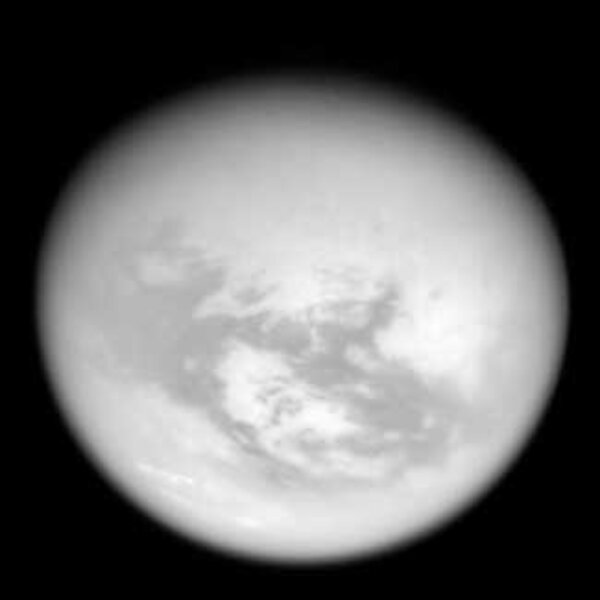Scientists spot massive methane rainstorm over Titan
Loading...
Worried about nasty tropical weather? Be glad you're not on Saturn's moon Titan.
Astronomers have discovered a storm system on Titan the size of India. It popped up in April 2008 in the moon's tropics, a latitude belt not known for cloudiness.
The storm, reported in the latest edition of the journal Nature, is another "a-ha" moment as scientists try to figure out how Titan's bizarre atmosphere works and the forces responsible for sculpting the moon's surface.
"These types of dramatic global weather events on Titan are rare and only last a few weeks," notes Henry Roe, an astronomer at the Lowell Observatory in Arizona and member of the team reporting the results.
The events suggested an atmosphere whose storm systems can significantly disturb Titan's equivalent of Earth's jet streams, triggering cloudiness elsewhere. It also helps explain why the surface in the tropics appears heavily sculpted by liquids despite the general dearth of clouds, the team suggests.
The European Space Agency's Huygens probe in 2004 returned pictures of what looked liked stream beds and other features seemingly carved by liquid on Titan's surface. Their structures implied they had formed under heavy downpours, much like what one sees in the US's desert Southwest.
An early Earth?
Indeed, the longer researchers stare at Titan, the more Earth-like its processes appear – processes playing out right before their telescopes' and spacecraft's sensors.
"It's really surprising how closely Titan's surface resembles Earth's," noted Rosaly Lopes, a planetary scientist at NASA's Jet Propulsion Laboratory in Pasadena, Calif., at a recent meeting of the International Astronomical Union in Brazil. "Titan looks more like the Earth than any other body in the solar system, despite the huge differences in temperature and other environmental conditions."
Titan is bigger than Mercury. It's the only moon with a dense atmosphere – 98 percent nitrogen. And it's bitterly cold. The average temperature at the surface is -179 degrees Celsius (-290 degrees Fahrenheit). On Earth, water is a major sculpting agent. On Titan, water is frozen hard as a rock; the sculpting agent is liquid methane and ethane, which rains out of clouds composed of these hydrocarbons.
The moon's atmosphere is thought to resemble that of Earth early in its history. This has raised the question of whether Titan is a spot in the solar system where chemical reactions that form the foundation for organic life are taking place. Some researchers suggest that simple forms of microbial life could exist beneath Titan's crust.
Cloudbursts of liquid methane
Clouds are important tools for studying a planet's atmosphere, but on any given year, clouds cover roughly 1 percent of Titan's disk versus 65 percent for Earth.
After noteworthy sightings of clouds on Titan in 1995 and again in 2004, a team of astronomers from the University of Hawaii, the Lowell Observatory, and the California Institute of Technology mounted a two-year program to track the moon's clouds. They used NASA's Infrared Telescope Facility on Hawaii's Mauna Kea volcano.
In April 2008, a large cloud system appeared, the team reports.
For lead investigator and University of Arizona planetary scientist Emily Schaller, "it was Titan's little present to me." Her newly minted PhD from Caltech involved the study of Titan's clouds, but for most of the time she was gathering data for it, "nothing much happened," she recalls. Then, the day she handed in her work, the storm appeared.
To the researchers' surprise, the vast storm system appeared in the tropics where it is rarely cloudy – its trigger unknown. In addition, it apparently spawned cloud formation near the south pole – during a season when the south polar region should be cloud-free.
Cloudbursts of liquid methane are not the only forces shaping Titan's surface. At last week's IAU meeting, scientists described volcanic activity, with slush-like mixtures of water ice and ammonia – a natural antifreeze – replacing scorching lava.
In addition, researchers presented models for mountain-building on Titan where mountain ranges resulted from the surface getting squeezed as it cooled and contracted. The surface also hosts the Titan equivalent of wind-drive sand dunes, as well as hydrocarbon lakes.





